What is LAGO?
Latin American Giant Observatory (LAGO)
The LAGO Project is an extended astroparticle observatory at a global scale. It is mainly oriented to basic research on three branches of astroparticle physics: the extreme universe, space weather phenomena, and atmospheric radiation at ground level. These are the needed components of other researches on high energy physics, weather forecasting, life sciences, aerospatial security or computer science.
The LAGO detection network consists of single or small arrays of self-designed Water-Cherenkov detectors (WCDs). These particle detectors are spanned over different sites located at significantly different latitudes (currently from Mexico to the Antarctic region) and different altitudes (from sea level up to more than 5,000 meters over sea level), covering a huge range of geomagnetic rigidity cut-offs and atmospheric absorption/reaction levels.
The LAGO Project is operated by the LAGO Collaboration, a non-centralized and distributed collaborative network of more than 100 scientists from almost 30 institutions in 11 countries. Several universities have incorporated LAGO studies into their curricula. Their students, especially the ones belonging to physics, electronics and computing areas, also contribute to the development of LAGO technologies.
